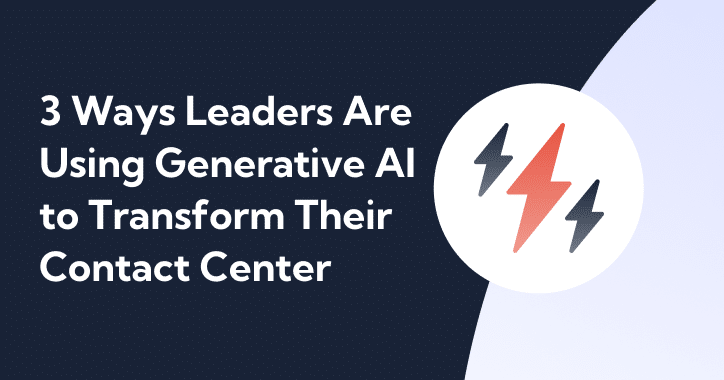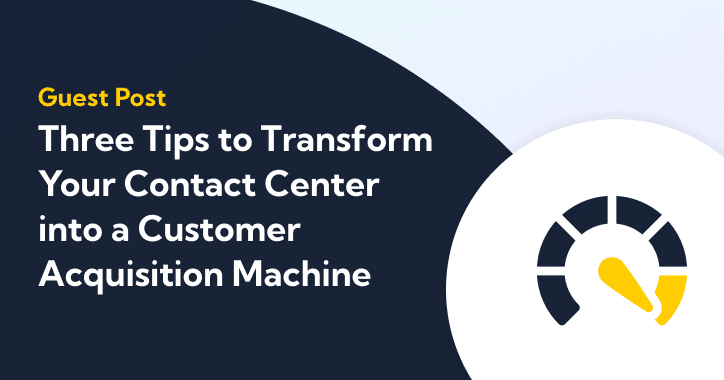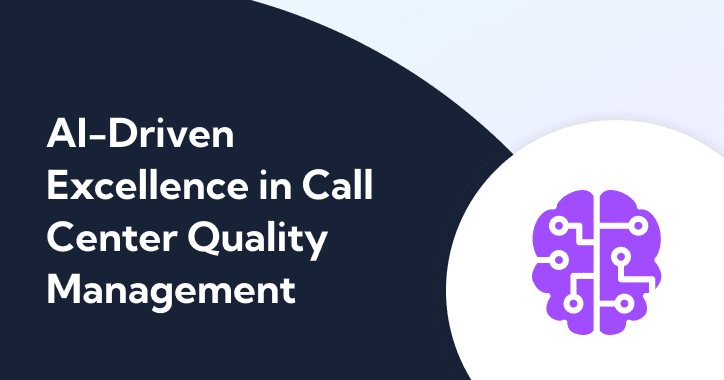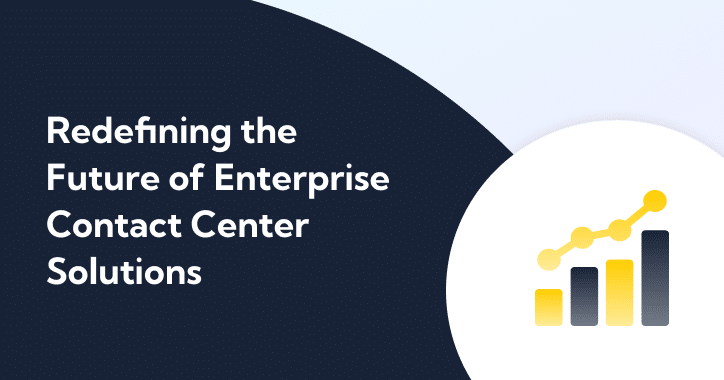The advancements in Generative Artificial Intelligence (Generative AI) have dominated the headlines and social media discussions throughout 2023, and for good reason. It’s a massive leap forward in the world of Artificial Intelligence and Machine Learning.
While the concept of generative AI isn’t really a new thing, the fact that it has become so smart, accessible, and easy to use is why companies are racing to implement it in their arsenals.
We’ve seen generative AI being applied in different industries with great results, specifically in the contact center domain.
This blog aims to uncover the numerous use cases of generative AI in the modern contact center. We’ll help you understand how generative AI can skyrocket your contact center’s efficiency, improve data analysis capabilities, streamline QA and coaching processes, and make customers happier.

What Is Generative AI?
Generative AI is a type of artificial intelligence that’s capable of producing new content in the form of text, audio, imagery, and various other formats.
Generative AI can boost your team’s productivity and make accessing, collecting, and analyzing data and getting useful insights much faster and easier. This helps you and your team direct your efforts to what matters most: delivering exceptional customer experiences.
A Brief Overview of the History of Generative AI
Contrary to popular belief, AI models have been around for quite some time now, long before the recent generative AI boom in text, video, and image generation.
But there’s a difference: before generative AI, the machine learning models we had were considered predictive. In other words, the model used to be able to make predictions, such as whether a soccer team may beat the other team in the final match of the tournament.
Generative AI models, on the other hand, are capable of generating new data, rather than making predictions based on the data it’s trained on. So, for instance, if you ask a generative AI model to write you a kids’ story about an elephant that got lost in the woods, the model will go through the millions of examples it has in its data sets and come up with a new story for you, with unique characters, challenges, resolutions, and realistic images.
Generative AI models, as we know them today, are based on more than 50 years of progress in computational power and research. In fact, the earliest form of generative AI was introduced in the 60s, but of course, computers lacked the computational power needed to make the technology accessible to the masses.
Not to mention, it wasn’t until recently that generative AI models had simple, chatbot-like interfaces that enabled anyone to interact with them easily, regardless of their technical background.
It’s also worth noting that language models have gone through many phases of development. Earlier models weren’t smart enough to be able to do anything more advanced than some basic operations and applications.
How Does Generative AI Work?
Generative AI models are based on recurrent neural networks – similar to those found in the human brain – capable of detecting trends and patterns in large data sets. Based on the analysis, the models produce new content that matches the user’s query.
Many generative AI models enable users to utilize both supervised and unsupervised training. This is actually one of the primary reasons why so many businesses now are keen on exploring potential AI applications in their industries. According to Gartner, we can expect a five-fold increase in agent interaction automation by 2026.
To elaborate, there are foundation models, such as GPT-4 and Stable Diffusion models. These models are trained on large amounts of data, but they may lack the data needed to perform in a specific scenario.
For example, imagine a large medical facility implementing an AI system using foundation models. While these models are powerful, they might not have specific knowledge about the facility’s internal processes or patient data.
To address this gap, the organization can fine-tune these base models by training them on their own data. By doing so, the AI assistant becomes more adept at understanding medical workflows, patient history, and the unique challenges faced by the facility, offering tailored and context-aware insights for better decision-making within the healthcare setting.
Revolutionizing Your Contact Center with Generative AI: Top 10 Benefits and Use Cases
Now let’s explore some of the most impactful use cases of generative AI in the contact center.
1. Get Insights About Your Call Center Performance at a Glance
With Generative AI language models, getting insights about your contact center’s performance is easier than ever. All you have to do is ask the model about what you need to know.
For example, if you want to know what your agents’ AHT (Average Handling Time) is in real time, you can just ask “What is the average handling time today?”
But that’s just a small part of what you can do with an advanced language model — you can do more things, such as comparing this quarter’s metrics with those of the previous quarters. You can also use it to generate ideas for your coaching plan by asking it to provide you with some of the strengths and weaknesses of each agent and how to improve them.
2. Monitor and Ensure Compliance
Maintaining compliance is foundational for your contact center. It fosters customer trust, maintains a positive brand image, and helps you avoid hefty fines and penalties.
In a contact center environment, compliance mistakes, especially recurring ones, can quickly turn into disastrous lawsuits and revenue losses.
With generative AI, your compliance team can take a proactive approach to compliance by quickly identifying trends and handling issues in real time. Instead of waiting for a compliance issue to turn into a bigger problem, you can fine-tune your generative model to get compliance insights whenever an attention-worthy issue is detected.
Some of the queries you can use to obtain compliance insights are:
- “Did any agents forget to properly authenticate customers before proceeding with the call? Does this happen on particular types of interactions or queries?”
- “Do customers mistakenly provide sensitive payment details to agents? How do agents react?”
- “What makes an agent more likely to forget to tell the customer that the call is being recorded? Give me three possible reasons.”
This approach is much more effective and inspiring than just using scorecards. Most of the time, a scorecard won’t give you the full picture, and manual compliance checking is often inaccurate and lacks context. Generative AI possesses analytical and critical thinking capabilities, providing you with actionable insights that let you improve compliance across your entire contact center.
3. Capture Coachable Moments Easily
In a call center environment, no matter how many coaching sessions you hold, you won’t notice tangible performance improvements unless you incorporate real-world coachable moments into your sessions.
Generative AI solutions are capable of spotting the areas agents typically struggle in, without forcing you to spend hours listening to calls and checking call summaries and notes.
The manual, time-consuming approach means that you’ll have to compromise and make your coaching sessions much more generic than they should be. After all, you probably have dozens, if not hundreds of agents to coach.
Call center managers spend 5x more time preparing for coaching sessions than actually coaching. This isn’t the case with generative AI solutions. Using a generative AI solution, you can get detailed insights about each agent’s performance and understand their strengths and weaknesses with simple inquiries.
What would typically take you hours of work could be processed in a couple of minutes, enabling you to create personalized coaching plans that address the shortcomings of each agent. Here are some of the inquiries you can utilize:
- “How many times did Mike. B fail to understand the customer’s query?”
- “Give me a piece of advice I can give Sara. F to help her provide better support in technical customer queries.”
- “Why is Tiffany. W’s sale closure rate going down? Give me three possible reasons.”
4. Automate Post-Call Work
Generative AI assistants can act as real-time notetakers by automatically summarizing 100% of calls, relieving your agents from the burden of manual note-taking.
With this tool, after-call work becomes a breeze as it automates time-consuming processes, ensuring that comprehensive and compliant notes are generated effortlessly with just a single click.
5. Improve Decision Making With Efficient Root-Cause Analysis
The right decisions can transform your contact center and help you hit your objectives. The tricky part is, that while many contact center managers think they’re getting their hands on the problems that hinder their contact center’s performance, they still fail to identify the root causes.
Generative AI algorithms are capable of collecting and analyzing vast amounts of data and customer interactions, identifying patterns and trends in customer and agent behavior. They uncover the issues that have the highest impact on your call center’s performance and customer satisfaction rates.
Once the algorithms spot the underlying problems, you get comprehensive and insightful data-based reports and forecasts that help you make sound decisions. And the best part? The process is almost fully automated, ensuring that you don’t occupy your team with redundant, time-consuming data collection tasks.
6. Reduce Manual Work and Focus on Improvement
If you want to improve your contact center performance and deliver better customer experiences, you need data — lots of it. The truth is manual data collection can be very resource-intensive, and no matter how hard you try, you won’t be able to get the full picture.
But that’s only half the story; after you spend tremendous resources to collect this often incomplete data, you need to figure out a way to put it into use, which introduces a new challenge: transforming the data into actionable analytics.
That’s where generative AI saves the day. A generative AI model can be trained on huge amounts of data from your customer interactions, and all you have to do to get the insights you want is to just ask. With generative AI, you’ll be saving countless hours of work and money. The cherry on top is that you’ll have more time to focus on actual improvements that result in a higher ROI (Return on Investment).
7. Learn What Works and Scale It
Uncovering best practices is a great first step, but it doesn’t end there — you need an efficient way to scale these best practices to your entire team.
With generative AI and Natural Language Processing (NLP) models, you can analyze customer interactions and identify coaching opportunities. For instance, if a customer service representative consistently handles challenging situations effectively, the AI can generate personalized coaching tips for other team members based on those successful interactions.
AI models can analyze historical data to identify patterns associated with successful interactions. For example, if certain phrases or approaches consistently lead to positive outcomes, the AI bot can recommend incorporating these best practices into the team’s communication strategy.
Instead of using your rockstar agent as a good example, you can utilize generative AI models to extract all the best practices that all of your team members are doing. You don’t need to focus on one team member — everyone in your team brings something new to the table, and what better way to empower your agents than by making best practices more accessible?
That’s where generative AI acts as a game-changer. Pulling out best practices from every single agent involves a higher level of complexity, as it requires an intelligent system not just to monitor specific calls from one agent, but to listen to all calls from all agents.
Initially, it needs to identify the top-performing agents and then analyze the resulting subset of calls for patterns and context — only generative AI is capable of proficiently handling such intricate logic.
Some of the queries you can use include:
- “List ten instances where agents effectively closed challenging sales. Include relevant transcripts and call audio.”
- “Explain why there were no wins today. Provide five reasons with concrete examples.”
- “In the last 90 days, identify the most successful tactic for overcoming budget objections. Share transcripts showcasing this tactic.”
8. Generate Agent Scripts
With generative AI, you can easily draft and fine-tune agent scripts for different customer interactions. Instead of using generic and repetitive scripts, AI lets you create personalized agent scripts that take factors like the customer’s past interactions and their personal preferences and needs into consideration.
This helps you maintain consistent communication with your customers and ensure that agents remain compliant with your company’s guidelines and key messaging.
9. Automate Email Responses
Generative AI systems let you make the most out of automated email responses. Traditionally, contact centers would just create an email response template that gets sent to all customers when they send an email. Usually, it’s just an email that lets them know their message is received and someone will get back to them as soon as possible.
Generative AI takes automated email responses one step further by understanding the customer’s query and attempting to resolve it based on training data from your knowledge base, without having to involve a human agent.
This can drastically improve your contact center’s efficiency and free up your agents to focus on more complex queries while generative AI handles the repeated ones. It also results in a faster, more consistent customer experience.
10. Create Voices for Customer Service and Client Calls
Many customer queries are simple and repetitive — they typically don’t require direct agent involvement.
With generative AI tools, you can utilize audio and voice synthesis to develop artificial self-service voices that closely resemble human speech patterns. This can help you handle more customer service calls, resolve complex queries, and route calls to the appropriate human representatives.
At the same time, you’re not frustrating your customers by making them feel like they’re talking to a cheaply built piece of software.
11. Enable 24/7 Customer Support
Using generative AI solutions allows you to offer continuous and reliable customer support, even outside business hours.
You can incorporate self-service channels based on generative AI, such as dynamic customer awareness sessions, AI chatbots, and automated email responses.
12. Create Comprehensive, Continuously Refreshed Knowledge Bases
With a generative AI system, you can create extensive knowledge bases and generate FAQs, troubleshooting guides, and instructional content based on real-time customer interactions, ensuring that the knowledge base remains current and relevant.
You can also use generative AI to create internal knowledge bases for your agents to develop their skills and recall information when required.
Potential Challenges of Implementing Generative AI in Your Contact Center
While there are numerous benefits to adopting generative AI techniques in contact centers, there are also challenges and limitations to consider.
Complex Inquiries May Lead to Inaccurate Answers
AI language models have come a long way, and they’ll continue to get better, but for now, it can be hard to expect a high level of accuracy from generative AI models if the inquiries are too complex.
Inquiries that include multiple orders and questions may exceed the capabilities of the language model, leading to inaccurate responses. Nevertheless, the more data you feed the model, the better it gets in terms of accuracy.
Large Language Models May Display Bias
Bias is one of the inevitable limitations of AI language models. Hurtful, toxic, and polarizing responses can be all expected from generative AI models. The good news is you can control what the model can and cannot provide responses to, to some extent at least.
Still, we need to mitigate the biases in deep generative models more effectively, especially with past incidents proving how bad it can get at times.
Customization and Fine-Tuning
Generative AI models, without fine-tuning, will give you generic, and possibly inaccurate, responses.
So, for example, if you try to use a random, all-purpose GPT model from the internet to help you get some tasks done in your contact center, you’ll be disappointed. Not to mention, you’ll be risking exposing your company’s sensitive information, leading to legal consequences.
Continuously training a GPT model on your contact center’s data, both from scratch and in the long run, is going to yield much better benefits for your contact center.
You can assess the effectiveness of a generative AI model in 3 ways: quality, speed, and diversity.
Poor speech quality can negatively impact effective communication. Speed should also be a concern for you — if the model is going to take forever every time you give it a simple inquiry, you’ll likely end up wasting a lot of time that could’ve been spent doing something more productive.
In addition, a good AI model should be capable of capturing minority modes in data distributions while minimizing bias and maintaining quality responses.
Data Privacy and Security Concerns
Implementing generative AI raises concerns about data privacy and security. Therefore, you need to establish robust measures to safeguard sensitive information and ensure compliance with regulations.
BaltoGPT: A Game-Changing Generative AI Solution for Your Contact Center
BaltoGPT revolutionizes the contact center through its instant and reliable information delivery. It functions as a real-time analytical tool, addressing leadership queries and providing personalized managerial assistance, as well as ensuring prompt decision-making.
The real-time note taking feature automates after-call work, summarizing 100% of calls and streamlining post-call processes. This improves productivity by allowing agents to focus on delivering exceptional customer service. At the same time, BaltoGPT prioritizes safety and trust, emphasizing reliability and security in its design.
BaltoGPT provides tangible benefits for your contact center, as evidenced by real-world results:
- +26% More Conversions: Elevate your conversion rates with insights and guidance provided by BaltoGPT.
- +45% Higher CSAT: Deliver exceptional customer experiences that lead to increased customer satisfaction.
- -60s Lower AHT: Streamline operations with reduced Average Handling Time (AHT), enhancing overall efficiency.
- +115% Increase in Compliance: Ensure regulatory compliance and build a contact center that operates seamlessly within industry standards.
- $3M+ Recaptured Revenue: Witness a substantial return on investment as BaltoGPT helps you recapture lost revenue.
Harness the Full Potential of Generative AI with BaltoGPT
Ready to revolutionize your contact center? Get a FREE demo now to explore the capabilities of BaltoGPT, and witness firsthand how generative AI can redefine contact center efficiency and success.






